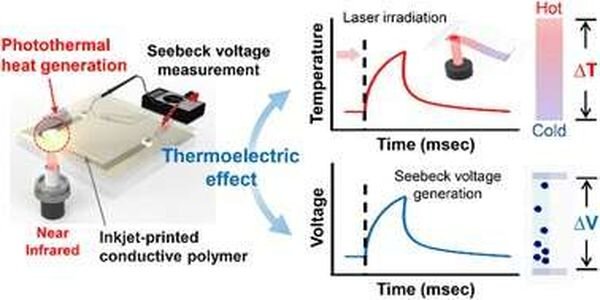Bio-friendly transparent temperature sensor technology that precisely measures temperature changes by light
Researchers have developed a transparent temperature sensor capable of precisely and quickly measuring temperature changes caused by light. This technology is expected to contribute to the advancement of various applied bio devices that rely on sensitive temperature changes.
The photothermal effect using plasmonic nanomaterials has recently been widely proposed in various bio-application fields, such as brain nerve stimulation, drug delivery, cancer treatment, and ultra-high-speed PCR due to its unique heating properties using light. However, measuring temperature changes by photothermal phenomena still relies on an indirect and slow measurement method using a thermal imaging camera, leading to the limitation that it is not suitable for local temperature measurement at the level of a single cell, which changes rapidly at the level of several milliseconds to tens of micrometers.
Due to the absence of precise information on temperature changes, photothermal effect technology has raised concerns about the understanding of biological changes and stable clinical application resulting from precise temperature changes, despite the spreading effect of its application.
Accordingly, the joint research team, which included Professor Kang Hong-gi of the Department of Electrical Engineering and Computer Science at DGIST and Dr. Chung Seung-jun of the Soft Hybrid Materials Research Center at KIST, developed a temperature sensor technology that can measure even rapid temperature changes in less than a few milliseconds by using the thermoelectric effect, in which a voltage signal is generated by rapid charge transfer triggered by a difference in temperature.
In particular, the team established a direct photothermal phenomenon measurement technology with reduced interference by light utilizing an organic thermoelectric layer of transparent PEDOT:PSS, a conductive polymer suitable for storing charges.
The 50-nanometer thin PEDOT:PSS thermoelectric sensor secures high transparency at 97% on average in the visible light zone and can be directly applied to the area of photothermal phenomenon, minimizing light interference for various photothermal bioengineering and medical applications. In addition, since a low-temperature solution process could be used for the polymer thermoelectric material used, it was prepared using an inkjet printing process, which is simpler to manufacture than a general semiconductor process, with a high degree of design freedom thus giving it an advantage in the printing process.
The transparent thermoelectric temperature sensor technology developed through this study can be used to understand the mechanism of the optical neural interface for controlling brain activity using light, which has recently been known broadly through optogenetics. It is a key technology in that it can be utilized to analyze the principles in treating cancer cells with local high heat. In addition, it is expected that it can be applied to next-generation semiconductor technologies, such as wearable devices, transparent display devices, and analysis of local deterioration of power semiconductors, based on the principle of powerless operation.
DGIST Department of Electrical Engineering and Computer Science Professor Kang Hong-gi said, "It is significant in that we proposed a technology that directly and precisely measures the photothermal effect, the biggest advantage of which is rapid generation of local heat," and added, "We look forward to the possibility of in-depth bioengineering analysis and biomedical application by combining it with various bio-electronic chips through micro-semiconductor processes in the future."
The study was published online in Materials Horizons,
More information:
Junhee Lee et al, High temporal resolution transparent thermoelectric temperature sensors for photothermal effect sensing, Materials Horizons (2022). DOI: 10.1039/D2MH00813K
Provided by
DGIST (Daegu Gyeongbuk Institute of Science and Technology)
Citation:
Bio-friendly transparent temperature sensor technology that precisely measures temperature changes by light (2022, December 29)
retrieved 29 December 2022
from https://phys.org/news/2022-12-bio-friendly-transparent-temperature-sensor-technology.html
This document is subject to copyright. Apart from any fair dealing for the purpose of private study or research, no
part may be reproduced without the written permission. The content is provided for information purposes only.








Gloss